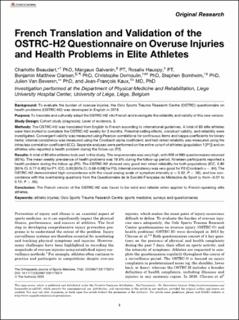| dc.contributor.author | Beaudart, Charlotte | |
| dc.contributor.author | Galvanin, Margaux | |
| dc.contributor.author | Hauspy, Rosalie | |
| dc.contributor.author | Clarsen, Benjamin Matthew | |
| dc.contributor.author | Demoulin, Christophe | |
| dc.contributor.author | Bornheim, Stephen | |
| dc.contributor.author | Van Beveren, Julien | |
| dc.contributor.author | Kaux, Jean-François | |
| dc.date.accessioned | 2023-09-18T13:38:04Z | |
| dc.date.available | 2023-09-18T13:38:04Z | |
| dc.date.created | 2023-06-23T10:56:08Z | |
| dc.date.issued | 2023 | |
| dc.identifier.citation | Orthopaedic Journal of Sports Medicine (OJSM). 2023, 11 (6), . | en_US |
| dc.identifier.issn | 2325-9671 | |
| dc.identifier.uri | https://hdl.handle.net/11250/3090160 | |
| dc.description.abstract | Background: To evaluate the burden of overuse injuries, the Oslo Sports Trauma Research Centre (OSTRC) questionnaire on health problems (OSTRC-H2) was developed in English in 2013. Purpose: To translate and culturally adapt the OSTRC-H2 into French and investigate the reliability and validity of this new version. Study Design: Cohort study (diagnosis); Level of evidence, 3. Methods: The OSTRC-H2 was translated from English to French according to international guidelines. A total of 80 elite athletes were then invited to complete the OSTRC-H2 weekly for 3 months. Potential ceiling effects, construct validity, and reliability were investigated. Convergent validity was measured using Pearson correlations for continuous items and kappa coefficients for binary items; internal consistency was measured using the Cronbach alpha coefficient; and test-retest reliability was measured using the intraclass correlation coefficient (ICC). Separate analyses were performed on the entire cohort of athletes (population 1 [P1]) and on athletes who reported a health problem during the follow-up (P2). Results: A total of 80 elite athletes took part in this study. The response rate was very high, with 909 of 960 questionnaires returned (95%). The mean weekly prevalence of health problems was 19.6% during the follow-up period. Nineteen participants reported a health problem during the follow-up (P2). The OSTRC-H2 showed very good test-retest reliability for both populations (ICC, 0.85 [95% CI, 0.77-0.90] for P1; ICC, 0.90 [95% CI, 0.68-0.98] for P2). Internal consistency was very good for P2 (Cronbach α = .94). The OSTRC-H2 demonstrated high concordance with the visual analog scale of symptom intensity (r = 0.52; P < .05), and low concordance with the overtraining questions from the Questionnaire de la Société Française de Médecine du Sport (κ from –0.01 to 0.12; P > .05). Conclusion: The French version of the OSTRC-H2 was found to be valid and reliable when applied to French-speaking elite athletes. | en_US |
| dc.language.iso | eng | en_US |
| dc.publisher | Sage | en_US |
| dc.rights | Attribution-NonCommercial-NoDerivatives 4.0 Internasjonal | * |
| dc.rights.uri | http://creativecommons.org/licenses/by-nc-nd/4.0/deed.no | * |
| dc.title | French Translation and Validation of the OSTRC-H2 Questionnaire on Overuse Injuries and Health Problems in Elite Athletes | en_US |
| dc.type | Peer reviewed | en_US |
| dc.type | Journal article | en_US |
| dc.description.version | publishedVersion | en_US |
| dc.rights.holder | © The Author(s) 2023 | en_US |
| dc.source.pagenumber | 7 | en_US |
| dc.source.volume | 11 | en_US |
| dc.source.journal | Orthopaedic Journal of Sports Medicine (OJSM) | en_US |
| dc.source.issue | 6 | en_US |
| dc.identifier.doi | 10.1177/23259671231173374 | |
| dc.identifier.cristin | 2157382 | |
| cristin.ispublished | true | |
| cristin.fulltext | original | |
| cristin.qualitycode | 1 | |

